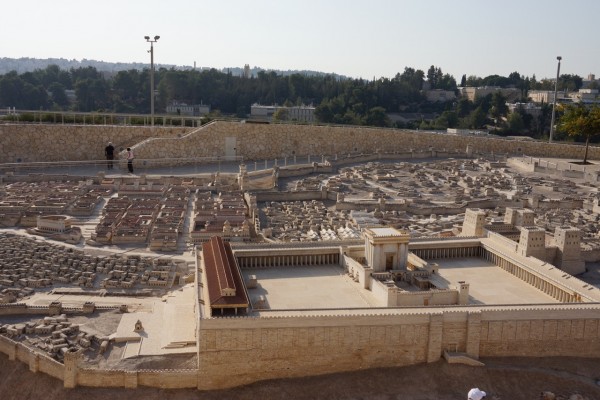Some of His disciples were remarking about how the temple was adorned with beautiful stones and with gifts dedicated to God. –Luke 21:5
The disciples who made this remark might have been anywhere in the Jerusalem Temple, for it was all beautiful. But my guess is that they stood before the enormous front door, 164 feet high and equally wide, that opened into the sanctuary.
Curled along the top of this entrance was a vine of gold hung with bunches of grapes as tall as a man. Worshippers could donate a golden leaf, a grape, or a bunch of grapes as a “gift dedicated to God.”
Luke’s account of these country boys from Galilee who were wowed by the Temple differs somewhat from Mark’s. In Mark’s version just one disciple exclaims, not over the beauty of the architecture, but over “what massive stones” composed it (13:1). Both in size and in splendor the Temple was indeed an extraordinary phenomenon. The accompanying photograph of a 1:50 scale model, though it gives but a faint impression of the original, shows how it dominated the city. Located at the Israel Museum, the model recreates Jerusalem in 66 AD, just four years before its final destruction by the Romans.
At that time little had changed from the days of Jesus a generation earlier. This was where He debated with the elders as a twelve-year-old boy, where He regularly attended festivals throughout His life, and where He taught as an adult. Here He spoke about the Good Shepherd, confronted the Pharisees, and drove out the money-changers. Here, during the Feast of Tabernacles, huge candlesticks were lit in the Women’s Court, which probably occasioned Jesus’ testimony, “I am the light of the world” (Jn 8:12, 20).
This was the Second Temple, begun by King Herod the Great in 19 BC. Herod’s Temple supplanted a smaller one that had replaced the original temple destroyed by the Babylonians in 587 BC. We know what Herod’s Temple was like from a description by Josephus, a former priest, and from rabbinical accounts, both orally-preserved and written, compiled in the Mishnah at the end of the second century. In addition we have an abundance of recent archaeological discoveries, many described in this book.
The Temple was built on the summit of Mount Moriah, which Herod, in a bid to aggrandize himself, had lowered. In order to accomodate the regular influx of over 100,000 pilgrims during festivals, Herod set about to double the area of the Temple Mount. He moved tons of earth, leveled the whole platform, built monumental retaining walls, and essentially turned the top of the mountain into a huge stone box. The result was an architectural feat unequaled anywhere in the Roman Empire. The central building of marble and gold stood higher than fifteen stories, while the Temple platform was the size of twenty-four football fields, twice as big as the ancient Roman forum and nearly ten times as large as the modern St. Peter’s. To pilgrims seeing it for the first time, wrote Josephus, it appeared “like a mountain covered with snow.”
This Temple did not simply represent God’s presence, it was God’s presence—His actual place of residence on earth. That is, until Jesus came to declare, “One greater than the temple is here” (Mt 12:6). Yet even He was not the final temple, the final resting place of God’s Spirit. No, all along the divine purpose was to inhabit all His children. As George Herbert expressed it in his poem “Man”:
None doth build a stately habitation
But he that means to dwell therein.
What house more stately hath there been,
Or can be, than is Man?
Next Week: Are Christmas Trees in the Bible?
(The book-in-progress, Jesus: His Story In Stone, will resume on January 6)
Photo by Karen Mason

